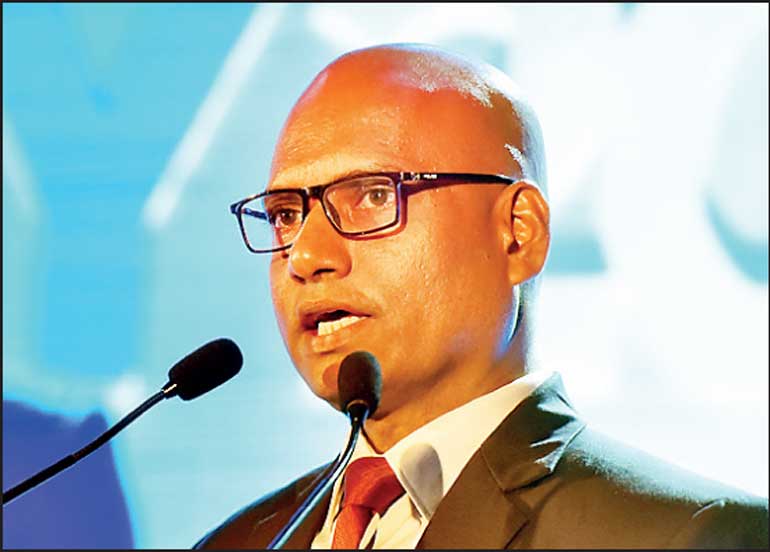Monday Apr 07, 2025
Monday Apr 07, 2025
Wednesday, 23 October 2024 00:00 - - {{hitsCtrl.values.hits}}

SLITHM and SLCB Chairman Dheera Hettiarachchi
– Pic by Lasantha Kumara
By Charumini de Silva
The newly appointed leadership of Sri Lanka Tourism has set ambitious targets to boost the industry, aiming to attract 4 million tourists and generate $ 8.5 billion in revenue over the next five years.
Speaking at the World Tourism Day 2024 celebration event held at the Cinnamon Grand yesterday, Sri Lanka Institute of Tourism and Hotel Management (SLITHM) and the Sri Lanka Convention Bureau (SLCB) Chairman Dheera Hettiarachchi outlined the new vision, a strategic shift from the previous regime’s focus in sheer visitor numbers, to increase the quality of the tourism experience while strengthening the sector’s long-term sustainability.
This was also the first public address by the new leadership since assuming office. Outlining the administration’s new vision which includes increasing the daily spending by tourists from the present $ 169 to $ 250 by 2030, while also doubling the human capital involved in the sector, reflecting broader focus on both quality and employment within the industry.
This marks a significant departure from the previous regime’s strategy, which had set a target of five million visitors by 2030 and emphasised attracting high-end tourists, aiming to generate $ 4,000 per visitor and encouraging half of these tourists to spend over $ 500 per day.
The current approach, Hettiarachchi explained, places greater emphasis on uniqueness and authenticity rather than focusing solely on volumes or high-end travellers.
“Our new national tourism policy is based on five key pillars – visionary leadership and strategic governance, sustainable utilisation of natural and cultural heritage, human capital development, innovative tourism products and strategic destination marketing,” he said.
These pillars, Hettiarachchi said were formulated with input from both local and international experts, underscoring the administration’s commitment to building a globally competitive and sustainable tourism sector.
He also highlighted the overcrowding at key tourist destinations, such as Sigiriya and Yala, as an issue that needs to be addressed in the interest of sustainability. “If we aim to drive tourism growth, it is critical that we preserve these assets for future generations.” he said, noting that it aligns with the administration’s broader focus on managing the carrying capacity of the country’s natural and cultural heritage sites.
To better carter to the growing demand for authentic and unique experiences, Hettiarachchi called for innovation within the sector, whilst urging the local universities with tourism-related degrees to contribute through research and development (R&D0, an area he said has been largely neglected for the past 58 years.
“Globetrotters today are well informed and increasingly seek authentic experiences. Our ability to meet those expectations will determine our success as a destination.” he said.
Beyond, traditional leisure tourism, Hettiarachchi also pointed to the substantial potential for Sri Lanka to develop as a MICE destination.
Discover Kapruka, the leading online shopping platform in Sri Lanka, where you can conveniently send Gifts and Flowers to your loved ones for any event including Valentine ’s Day. Explore a wide range of popular Shopping Categories on Kapruka, including Toys, Groceries, Electronics, Birthday Cakes, Fruits, Chocolates, Flower Bouquets, Clothing, Watches, Lingerie, Gift Sets and Jewellery. Also if you’re interested in selling with Kapruka, Partner Central by Kapruka is the best solution to start with. Moreover, through Kapruka Global Shop, you can also enjoy the convenience of purchasing products from renowned platforms like Amazon and eBay and have them delivered to Sri Lanka.
Discover Kapruka, the leading online shopping platform in Sri Lanka, where you can conveniently send Gifts and Flowers to your loved ones for any event including Valentine ’s Day. Explore a wide range of popular Shopping Categories on Kapruka, including Toys, Groceries, Electronics, Birthday Cakes, Fruits, Chocolates, Flower Bouquets, Clothing, Watches, Lingerie, Gift Sets and Jewellery. Also if you’re interested in selling with Kapruka, Partner Central by Kapruka is the best solution to start with. Moreover, through Kapruka Global Shop, you can also enjoy the convenience of purchasing products from renowned platforms like Amazon and eBay and have them delivered to Sri Lanka.